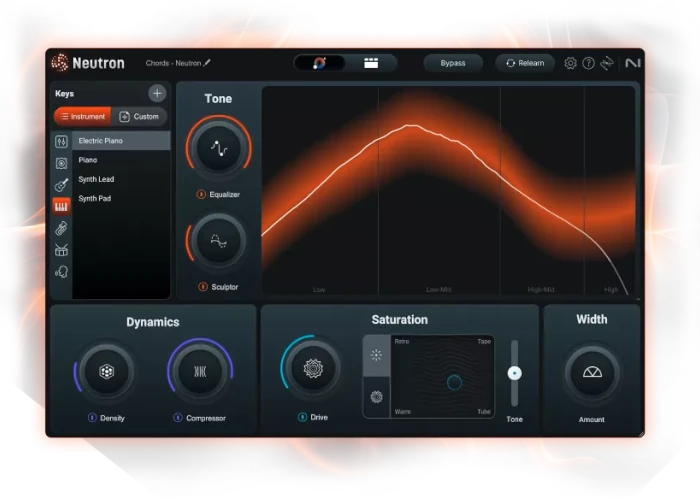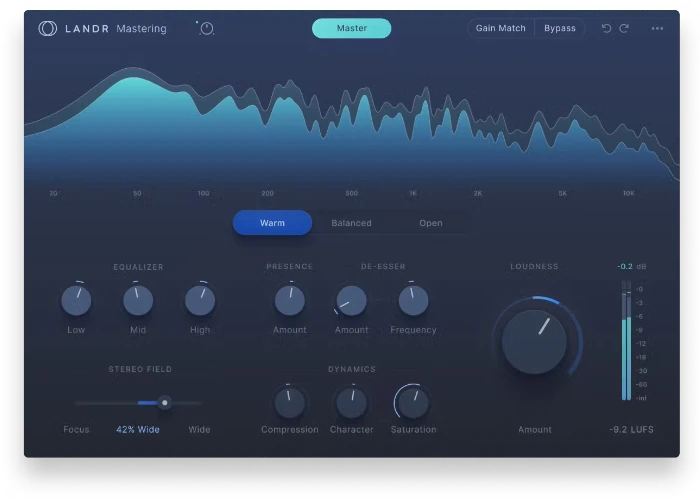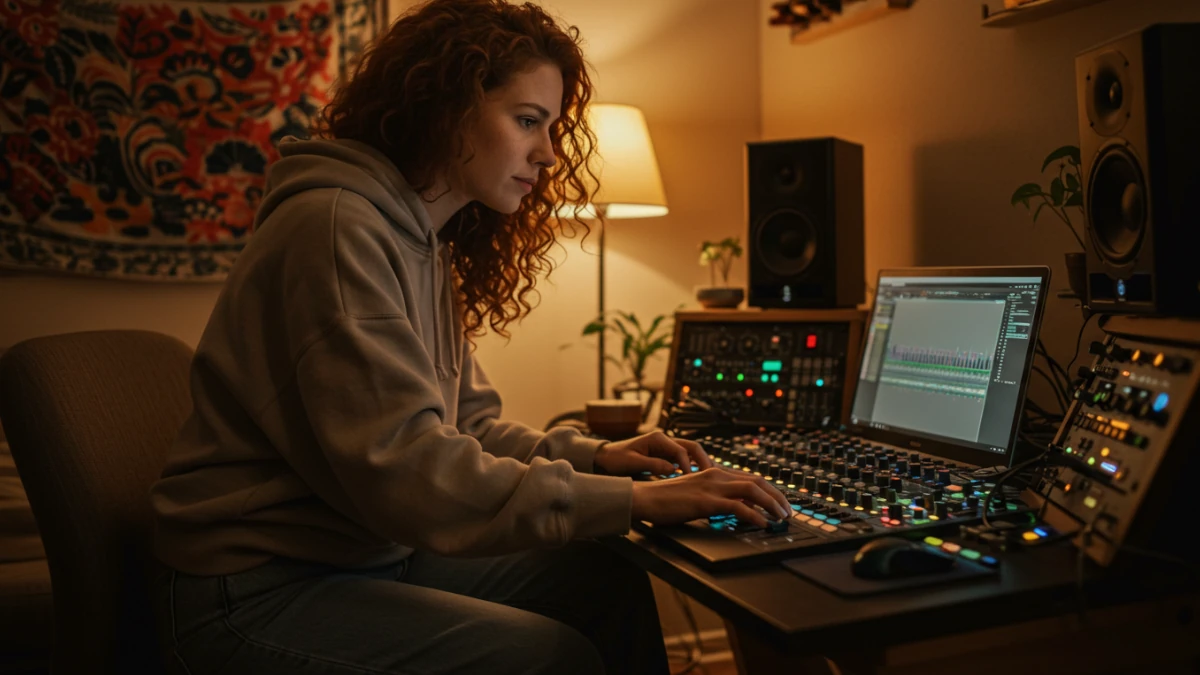HSS Podcast - AI-Powered Mixing Tools for Home Studios
HSS Staff
In the digital universe of music production, there’s a fresh buzzword that’s shaking up home studios across the globe: AI-powered mixing tools. Intrigued? You’re not alone. Imagine having a virtual assistant at your fingertips, capable of transforming raw tracks into polished hits with just a few clicks. Sounds like science fiction, right? Yet, this is today’s reality!
Gone are the days when you needed a multi-thousand-dollar setup or a degree in sound engineering to craft quality music. Now, artificial intelligence promises to help you play maestro in your cozy home studio. But does it really deliver on its claims, or is it just another tech gimmick? In this blog post, we will unravel the mysteries of these futuristic tools, dissect their capabilities, and explore if they truly hold value for the everyday musician. Buckle up as we journey into the exciting intersection of music and technology!
1. Understanding AI Algorithms in Music Production: An Overview
AI algorithms have become a game-changer in music production, especially in home studios where resources might be limited. These clever algorithms mimic human intelligence, learning from vast amounts of data to make decisions, and in our case, they help in creating and mixing music. But what exactly does this mean for someone trying to produce music at home?
How AI Algorithms Work in Music Production
At the core, AI algorithms analyze audio data and recognize patterns. For instance, they can identify frequencies that clash and suggest equalizer settings to improve the mix. These algorithms can even adjust levels, apply effects, and suggest mastering techniques – all tasks traditionally done by skilled sound engineers. Imagine an AI-powered tool that listens to your track and automatically adjusts the volume of each instrument to ensure nothing overpowers the lead vocal.
Real-Life Applications and Examples
Consider Ozone by iZotope, a popular AI-powered mixing tool. It uses machine learning to offer mastering suggestions based on the genre of your track. Another example is LANDR, an AI tool that automates the mastering process. These tools provide a great starting point for those who might not have years of mixing experience.
Practical Tips for Using AI in Home Studios
To make the most of these tools, start by familiarizing yourself with their presets and suggestions. Use them as a learning tool to understand how different adjustments affect your mix. Remember, while AI can significantly enhance your workflow, it’s essential to rely on your ears and personal taste to make the final decisions. It’s a dance of technology and creativity, where AI handles the grunt work, letting you focus on the artistic vision.
2. Comparing AI-Powered Mixing Tools
When it comes to AI-powered mixing tools, the variety available can be both exciting and overwhelming. These tools promise to revolutionize home studio mixing by offering speed, efficiency, and an often surprisingly accurate ear. But, are they living up to the hype? Let’s dive in!
Understanding Different Tools

First off, let’s break down a few popular AI mixing tools. iZotope Neutron is a widely respected tool that analyzes your mix and suggests EQ settings, compression, and other effects. Its “Mix Assistant” feature is particularly handy for beginners, providing a solid starting point for mixing tracks. Another player is LANDR, which not only offers AI mixing but also mastering, and has been praised for its user-friendly interface.
Use Case Scenarios
Consider a musician working from a home studio. Suppose you’re crafting a demo for potential collaborators. With AI tools like Neutron, you can quickly generate a polished mix, saving time and allowing more focus on creativity. For a podcast producer, LANDR’s AI can streamline the process of producing consistent audio levels across episodes, ensuring that dialogue is crisp and clear.
Practical Tips
To make the most of these tools, start by letting the AI handle initial settings. Then, tweak manually to add your personal touch. Always remember, AI is an assistant, not a replacement for your unique artistic input. Try running the same track through different AI tools to compare results—each has its strengths and might offer a unique advantage depending on the project.
In summary, while AI-powered mixing tools offer significant advantages in speed and accessibility, they shine brightest when used as part of a hybrid approach, combining machine precision with human intuition.
3. Cost
When diving into the world of AI-powered mixing tools for home studios, cost is a significant consideration. These tools, although incredibly powerful, come with a range of pricing options that can fit different budgets. Understanding the financial aspect can help you make an informed decision about whether these tools are worth your investment.
Initial Investment

To begin with, AI-powered mixing tools often require an initial investment. For example, popular tools like iZotope’s Neutron or LANDR offer different pricing tiers. A basic version might cost around $100, while more advanced features or bundles can run upwards of $500. The key is to evaluate what you really need. If you’re a beginner, the basic version might suffice to meet your needs without breaking the bank.
Subscription Models
Another cost aspect to consider is the subscription model many AI tools adopt. LANDR, for instance, offers monthly or yearly subscription plans. While these can seem cheaper upfront, they add up over time. On the flip side, they often include regular updates and additional features, which can be advantageous. Evaluate whether the ongoing cost aligns with your usage and production goals.
Free Alternatives
Not to be overlooked are free or freemium AI mixing tools available on the market. While they might not offer the extensive features of premium versions, they can be a great way to test the waters without committing financially. For instance, BandLab offers a free online DAW with AI mixing capabilities. It’s an excellent option for beginners or those on a tight budget.
Practical Tip: Start with a free trial or a basic version to see how these tools fit into your workflow. Assess if the time saved and the quality of output justify the cost before upgrading to more expensive options.
4. The Impact of AI on Music Creativity and Human Touch
Artificial Intelligence has revolutionized various aspects of music production, and one of its most intriguing impacts is on creativity and the human touch. AI-powered mixing tools for home studios are a perfect example of this shift. They offer unprecedented precision and efficiency, but they also raise questions about the role of human intuition in music.
Balancing AI and Human Creativity
AI mixing tools can analyze audio tracks, identify patterns, and suggest or even execute adjustments that might take human producers hours or even days to perfect. For instance, tools like iZotope’s Neutron use AI to identify instruments in a mix and provide tailored EQ settings. This can free up valuable time for producers, allowing them to focus on creative decisions rather than technical ones.
However, the human touch is irreplaceable when it comes to injecting emotion and artistic intent into music. AI can suggest a technically ‘perfect’ mix, but it might not capture the unique vibe or mood that a producer envisions. Therefore, a balanced approach, where AI handles repetitive tasks and humans make creative decisions, often yields the best results.
Practical Tips for Using AI in Music Production
To leverage AI effectively while retaining your creative edge, consider these tips:
- Use AI for technical tasks: Let AI handle tasks like noise reduction, basic EQ adjustments, and level balancing, freeing your creativity for more nuanced work.
- Don’t rely solely on AI: Always review AI-suggested changes with a critical ear and adjust based on your artistic goals.
- Stay informed: Keep up with the latest AI advancements to understand their capabilities and limitations fully.
While AI can significantly enhance music production processes, it should be seen as a tool to complement, not replace, the human touch that makes music uniquely expressive and powerful.
5. Future Trends and Innovations in AI
AI-powered mixing tools for home studios are not only here to stay but are also evolving at a rapid pace. These innovations are reshaping the music production landscape, making it more accessible and efficient. So, what does the future hold?
Adaptive Algorithms
The next generation of AI mixing tools will likely feature more adaptive algorithms. Imagine a tool that learns your unique style and preferences over time. It could suggest mixes that align closely with your past projects, effectively becoming a virtual assistant. For example, if you consistently favor a particular bass boost, the tool might automatically apply it, saving you time and effort.
Real-Time Collaboration
Future AI tools might also enable real-time collaboration. Picture working on a track with a friend in another city or even country, with AI facilitating seamless integration of ideas and edits. Tools could automatically suggest harmonies or rhythm changes that match both collaborators’ tastes, making remote collaboration as effective as being in the same room.
Augmented Reality (AR) Integration
AR is another exciting frontier. Envision mixing tracks with a virtual control room overlay in your physical space. This could make the process more intuitive and hands-on, merging traditional mixing techniques with futuristic technology. A practical tip is to stay updated with AR tech developments, as they might soon integrate with your existing setup.
Voice Command Capabilities
Voice command features could make AI mixing tools even more user-friendly. Imagine instructing your software to “bring up the vocals” or “add more reverb” without touching a mouse or keyboard. This could streamline workflows, allowing producers to focus more on creativity than technical adjustments.
In conclusion, these innovations suggest a future where music production becomes even more accessible and personalized, bridging the gap between professional and amateur producers. Staying informed and adaptable will be key to leveraging these advancements effectively.
Conclusion: Are AI-Powered Mixing Tools Worth the Investment for Home Studios?
In assessing the value of AI-powered mixing tools for home studios, several key insights emerge. First and foremost, these innovative tools provide an undeniable boost in efficiency. Imagine being able to cut down on hours of manual tweaking to achieve a polished mix; AI technologies like iZotope’s Neutron or LANDR can significantly streamline this process. Whether you’re an amateur producer or a seasoned pro, saving time means you can channel your creativity into more productive areas.
Moreover, the improved accessibility offered by AI tools can’t be overstated. Gone are the days when professional-grade mixes were solely the domain of those with expensive equipment and years of training. Now, with the help of artificial intelligence, anyone with a laptop and a modest budget can access sophisticated mixing techniques, leveling the playing field.
Despite these advantages, it’s essential to acknowledge the potential limitations. AI-driven tools may not capture the nuanced artistry that a human ear provides. Every producer must consider whether the trade-off between convenience and personal touch is a compromise they’re willing to make.
However, with rapid advancements underway, the integration of AI in music production will likely become even more refined. Observing real-life success stories from musicians who have crafted hit songs using AI-based systems further emphasizes their potential. For instance, electronic producers such as Taryn Southern and Amper Music have successfully leveraged AI to bring fresh sounds to many charts.
To wrap up, if you’re on the fence, the call-to-action is to give these AI-powered mixing tools a try. Engage with trial versions or limited-feature apps before making a full commitment to purchase. By experiencing firsthand what these tools can accomplish, you’ll make a more informed decision about how best to enhance your production workflow.
So, why wait? Explore the world of AI-powered mixing today and open your home studio to a realm of new possibilities. Your next big hit might just be an AI-assisted click away.

